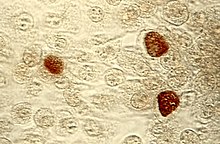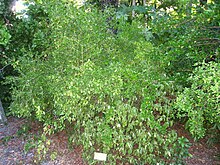클라미디오타
Chlamydiota| 클라미디오타 | |
|---|---|
 | |
| 클라미디아 트라코마티스 | |
| 과학적 분류 | |
| 도메인: | 박테리아 |
| 문: | 클라미디오타 Garrity & Holt 2021[3] |
| 클래스: | 클라미디아 혼[1][2] 2016 |
| 주문 및 패밀리 | |
| 동의어 | |
| |
클라미디오타(Chlamydiota)는 인간과 동물의 병원체, 유비쿼터스 [4]원생동물의 공생체,[5] 해양 퇴적물 형태 등 매우 다양한 구성원을 가진 박테리아 문과 클래스이다.인간이 수십 년 동안 알고 있는 클라미디오타는 모두 필수 세포 내 박테리아이다; 2020년에 많은 클라미디오타가 해저 환경에서 추가로 발견되었고, 그들 모두가 [5]숙주를 가지고 있는지는 아직 알려지지 않았다.역사적으로 모든 클라미디오타는 펩티도글리칸이 없는 세포벽을 가지고 있다고 믿었지만, 2010년대 연구는 펩티도글리칸과 다른 중요한 [6][7][8][9][10][11]단백질의 검출 가능한 존재를 보여주었다.
클라미디오타 중 과학적으로 오랫동안 알려진 것은 모두 진핵 숙주세포를 감염시켜 성장한다.그것들은 많은 바이러스들과 같거나 작습니다.그것들은 난형이고 그램 음성으로 염색된다.그들은 숙주 세포 내부의 복제에 의존한다. 따라서, 어떤 종은 의무 세포 내 병원체라고 불리며, 다른 종들은 유비쿼터스 원생동물의 공생체이다.대부분의 세포 내 클라미디오타는 포접체 또는 액포에 위치한다.세포 밖에서는 세포 외 감염 형태로만 살아남는다.클라미디오타는 숙주세포가 자라는 곳에서만 자랄 수 있고 특징적인 2상 발달 [12][13][14]주기에 따라 발달합니다.따라서 임상적으로 관련된 Clamydiota는 임상실험실의 세균배지에서 증식할 수 없다.그들은 숙주 세포 안에 있을 때 가장 성공적으로 격리된다.
인체의 질병을 일으키는 각종 클라미디오타 중 가장 중요한 2종은 폐렴의 일종인 클라미디아 폐렴과 클라미디아를 일으키는 클라미디아 트라코마티스다.클라미디아는 미국에서 가장 흔한 세균성 감염으로 연간 286만 건의 클라미디아 감염이 보고되고 있다.
역사
사람의 눈에 영향을 미치는 클라미디아 유사 질병은 고대 중국과 이집트의 필사본에서 처음 기술되었다.클라미디아와 유사한 유기체에 대한 현대적인 설명은 1907년 Halberstaedrter와 von Prowazek에 의해 제공되었다.배아 알의 노른자 주머니에서 배양된 클라미디아 분리제는 1920년대 후반과 1930년대 초에 발생한 인간 폐렴에서 얻었으며, 20세기 중반에는 수십 종의 척추동물에서 분리제를 얻었다.클라미디아(망토)라는 용어는 1945년 문헌에 등장했지만 베드소니아, 미야가와넬라, 조류증-, 트리시-, PLT-에이전트 등 다른 명칭이 계속 사용되었다.클라미디아 트라코마티스는 1956년 탕페이판에 의해 처음 배양됐지만 [15]아직 박테리아로 인식되지는 않았다.
명명법
1966년에 클라미디오타는 박테리아로 인정되었고 클라미디아속은 [16]검증되었다.클라미디아목은 1971년 Storz와 Page에 의해 만들어졌다.Clamydiia라는 클래스가 최근에 출판되었습니다.[17][18][19]1989년과 1999년 사이에 새로운 과, 속, 그리고 종들이 인정되었다.클라미디아 문(Clamydiae)은 Bergey의 체계적 세균학 [20]매뉴얼에서 확립되었다.2006년까지 350개 이상의 클라미디아 혈통에 대한 유전자 데이터가 [21]보고되었다.2020년에 보고된 해저 형태의 발견에는 새로운 [5]분지류가 포함된다.2022년 문명은 클라미디오타(Chlamydiota)[3]로 바뀌었다.
분류법 및 분자 서명
클라미디오타는 현재 8개의 유효한 이름을 가진 속과 14개의 [22]속을 포함하고 있다.현재 문(문)은 2개 목(클라미디아목, 파라클라미디아목)과 9개 과(클라미디아목)[17][18]로 구성되어 있다.이들 과 중 4개 과(클라미디아과, 파라클라미디아과, 심카니아과, 와들리아과)[23][24]만 유효한 명칭으로 불리며, 5개 과(클라미디아과, 크리블라미디아과, 파리클라미디아과, 피시클라미디아과, 라브도클라미디아과)[25][26][27]는 과로 설명된다.최근 기술된 클라미디아목은 클라미디아과와 클란치아미디아과를 포함하고 있으며, 새로운 파라클라미디아목은 나머지 7개 [17]과를 포함하고 있다.이 제안은 분류학적 서열 상위에 있는 두 개의 뚜렷한 계통발생학적 분류군의 관찰에 의해 뒷받침된다.보존된 인델(CSI)과 단백질(CSP)의 형태로 이루어진 분자 시그니처는 각각의 분리된 질서에 의해 고유하게 공유되는 것으로 밝혀졌으며, 각 질서에서 각 분지군을 구별하는 수단을 제공하고 각 [17][28]질서에 속한 가족의 공통 조상의 관점을 뒷받침한다.두 가지 순서의 구별성은 다른 계열 조합 중 CSI가 발견되지 않았다는 사실에서도 입증된다.
클라미디아과만의 분자적 특징도 발견되었다.[17][28]Chlamydiaceae는 원래 Chlamydia라는 한 속이었지만 1999년에 Chlamydophila와 Chlamydia라는 두 개의 속으로 나뉘었다.2015년 이후 이 속들은 클라미도필라속에 속하는 종들이 클라미디아 [29][30]종으로 재분류되면서 재결합했다.그러나 CSI와 CSP는 클라미도필라 종에 대해 특별히 발견되어 클라미디아와의 구별성을 뒷받침하고 있으며, 아마도 그 [17][28]과 내에서 두 개의 별개의 그룹을 추가로 고려할 필요가 있을 것이다.CSI와 CSP는 클라미도필라로부터 독립된 혈통을 더욱 나타내는 모든 클라미디아에 의해 배타적으로 공유되는 것으로 밝혀져 클라미디아 종과 인접한 클라미도필라 종과의 구별 수단을 뒷받침하고 있다.
계통학
클라미디오타는 약 10억 년 전에 다른 박테리아와 분리된 독특한 박테리아 진화군을 형성하며, 여러 CSI와 CSP의 [17][28][31][32]존재로 구분할 수 있다.이 그룹의 종은 많은 단백질에 보존된 인델의 존재와 다른 클라미디아 [33][34]종에 독특하게 존재하는 많은 수의 시그니처 단백질에 의해 다른 모든 박테리아와 구별될 수 있습니다.Chlamydiota가 Planctomycetota [35][36]또는 Spirochaetota와 관련이 있는지에 대한 보고는 다양했다.그러나 게놈 배열 분석 결과 프로토클라미디아 아메보필라 UWE25 유전자의 11%, 클라미디아과 유전자의 4%가 엽록체, 식물,[32] 시아노박테리아 유전자와 가장 유사한 것으로 나타났다.Cavalier-Smith는 Chlamydiota가 Gracilicutes의 Planctobacteria 분류군에 떨어진다고 가정했다.그러나 계통 특이적인 단백질에서 계통 발생과 CSI의 공유 존재는 Verrucomic biobota가 이러한 기생 [37]유기체의 가장 가까운 자유 생활 친척임을 나타냅니다.리보솜 RNA 유전자의 비교는 클라미디오타 [21]내에서 알려진 균주의 계통 발생을 제공했다.
인체 병원체 및 진단
인간을 흔히 감염시키는 클라미디오타 3종이 설명된다.
클라미디오타의 독특한 생리학적 상태에는 이들의 2상 라이프사이클과 진핵생물 숙주 내에서 복제될 의무가 포함되어 있어 클라미디아 [38]진단을 위한 DNA 분석을 사용할 수 있게 되었다.유전자의 수평 이동은 명백하고 이 연구 영역을 복잡하게 만든다.하나의 극단적인 예에서 진핵생물 기원의 히스톤 유사 H1 단백질을 코드하는 두 개의 유전자가 필수 세포 내 병원체인 C. 트라코마티스의 원핵생물 게놈에서 발견되었다.
계통발생학
계통 발생은 The All-Sexies Living Tree [39]Project의 16S rRNA 기반 LTP 릴리스 123을 기반으로 합니다.
| |||||||||||||||||||||||||||||||||||||||||||||||||
| 클라미디아과 |
| ||||||||||||||||||||||||||||||||||||||||||||||||
분류법
현재 승인된 분류법은 LPSN([40]Standing in Nomenclature)과 NCBI를[41] 가진 원핵생물 이름 목록을 기반으로 한다.
- 속 ? PischlamydiaDraghi et al. 2004년
- Pischlamydia 연어종 Draghi et al. 2004년
- 패밀리?ActinochlamydiaceaeSteigen et al. 2013
- 악티노클라미디아스테이겐 등 2013년
- 종악티노클라미디아클라리애스테이겐 외 2013
- 악티노클라미디아스테이겐 등 2013년
- 과? Clavichlamydiaceae2011년 경적
- 클라비클라미디아코리그속. 칼슨 외 2008년
- Clavichlamydia salmonicola corrig. 칼슨 외 2008년
- 클라비클라미디아코리그속. 칼슨 외 2008년
- 패밀리 ? Parilichlamydiaceae Stride 등. 2013
- ParilichlamydiaStride 등 2013년
- Parilichlamydia carangidicola Stread et al. 2013
- SimilichlamydiaStride 등 2013년
- ParilichlamydiaStride 등 2013년
- 크립아미디아과Thomas, Casson & Greub 2006
- 크립아미디아 Thomas, Casson & Greub 2006
- Cryblamydia sequanensis Thomas, Casson & Greub 2006 종
- 에스트렐라 토마스 외 2006년
- 에스트렐라 라우사넨시스 코르사로, 페롤디 & Greub 2007
- 크립아미디아 Thomas, Casson & Greub 2006
- 코르사로 등 과 2009년
- 레니클라미디아코르사로속 & 워크 2012
- 레니클라미디아 루자니 코르사로&워크 2012
- RhabdochlamydiaKostanjsek 등 2004년
- 종 R. crassificans Corsaro et al. 2007
- 종 R. porcelionis Kostanjsek et al. 2004년
- 레니클라미디아코르사로속 & 워크 2012
- Chlamydiaceae Rake 1957 emend. Everett, Bush & Andersen 1999
- 암피클라미디아마르텔 등 2012년
- "Candidatus Rubidus" Pagnier et al. 2015
- 종 "Candidatus Rubidus massiliensis" Pagnier 등 2015년
- ChlamydiaJones et al. 1945 emend. Everett, Bush & Andersen 1999
- ChlamydophilaEverett, Bush & Andersen 1999속
- 패밀리 파라클라미디아과 Everett, Bush & Andersen 1999
- MesochlamydiaCorsaro 등 2012년
- 메조클라미디아 엘로데아 코르사로 등 2012년
- 속 ? MetachlamydiaCorsaro et al. 2010
- Metachlamydia lacustris Corsaro et al. 2010
- 속 ? ProtochlamydiaCollingro 등 2005년
- 종 P. 아메보필라 콜링그로 외 2005
- 종 P. negleriophila Casson et al.
- 네오클라미디아속Horn 외 2001년
- Neochlamydia hartmannellae Horn et al. 2001
- ParchamydiaEverett, Bush & Andersen 1999속
- 품종 파라클라미디아 애칸타모에베, 부시 & 안데르센 1999
- MesochlamydiaCorsaro 등 2012년
- Simkaniaceae Everett, Bush & Andersen 1999 패밀리
- 속 ? FritscheaEverett 등 2005년
- 종 F. bemisiae Everett et al. 2005
- 종 F. eriocococci Everett et al. 2005
- 속 ? 넵투노클라미디아피제티 외 2016년
- 넵투노클라미디아벡실리페라피제티 등 2016년
- 속 ?승남미디아Fehr et al. 2013
- SimkaniaEverett속, Bush & Andersen 1999
- 심카니아 니게벤시스 에버렛, 부시 & 안데르센 1999종
- 속 ? FritscheaEverett 등 2005년
- Waddliaceae Rurangirwa 등 1999년
- WaddliaRurangirwa 등 1999년
- 종 W. 콘드로필라 루랑기르와 외 1999
- 종 W. malayiensis 추아 외 2005
- WaddliaRurangirwa 등 1999년
레퍼런스
- ^ Horn M. (2010). "Class I. Chlamydiia class. nov.". In Krieg NR, Staley JT, Brown DR, Hedlund BP, Paster BJ, Ward NL, Ludwig W, Whitman WB. (eds.). Bergey's Manual of Systematic Bacteriology. Vol. 4 (2nd ed.). New York, NY: Springer. p. 844. doi:10.1007/978-0-387-68572-4. ISBN 978-0-387-95042-6.
- ^ Oren A, Garrity GM. (2016). "Validation list no. 170. List of new names and new combinations previously effectively, but not validly, published". Int J Syst Evol Microbiol. 66: 2463–2466. doi:10.1099/ijsem.0.001149.
- ^ a b Oren A, Garrity GM (2021). "Valid publication of the names of forty-two phyla of prokaryotes". Int J Syst Evol Microbiol. 71 (10): 5056. doi:10.1099/ijsem.0.005056. PMID 34694987. S2CID 239887308.
- ^ Sixt BS, Siegl A, Müller C, Watzka M, Wultsch A, Tziotis D, et al. (2013). "Metabolic features of Protochlamydia amoebophila elementary bodies—a link between activity and infectivity in Chlamydiae". PLOS Pathogens. 9 (8): e1003553. doi:10.1371/journal.ppat.1003553. PMC 3738481. PMID 23950718.
- ^ a b c Dharamshi JE, Tamarit D, Eme L, Stairs CW, Martijn J, Homa F, et al. (March 2020). "Marine Sediments Illuminate Chlamydiae Diversity and Evolution". Current Biology. 30 (6): 1032–1048.e7. doi:10.1016/j.cub.2020.02.016. PMID 32142706. S2CID 212423997.
- ^ Pilhofer M, Aistleitner K, Biboy J, Gray J, Kuru E, Hall E, et al. (2013-12-02). "Discovery of chlamydial peptidoglycan reveals bacteria with murein sacculi but without FtsZ". Nature Communications. 4 (1): 2856. Bibcode:2013NatCo...4.2856P. doi:10.1038/ncomms3856. PMC 3847603. PMID 24292151.
- ^ Jacquier N, Viollier PH, Greub G (March 2015). "The role of peptidoglycan in chlamydial cell division: towards resolving the chlamydial anomaly". FEMS Microbiology Reviews. 39 (2): 262–275. doi:10.1093/femsre/fuv001. PMID 25670734.
- ^ Malhotra M, Sood S, Mukherjee A, Muralidhar S, Bala M (September 2013). "Genital Chlamydia trachomatis: an update". The Indian Journal of Medical Research. 138 (3): 303–316. PMC 3818592. PMID 24135174.
- ^ Liechti GW, Kuru E, Hall E, Kalinda A, Brun YV, VanNieuwenhze M, Maurelli AT (February 2014). "A new metabolic cell-wall labelling method reveals peptidoglycan in Chlamydia trachomatis". Nature. 506 (7489): 507–510. Bibcode:2014Natur.506..507L. doi:10.1038/nature12892. PMC 3997218. PMID 24336210.
- ^ Liechti G, Kuru E, Packiam M, Hsu YP, Tekkam S, Hall E, et al. (May 2016). "Pathogenic Chlamydia Lack a Classical Sacculus but Synthesize a Narrow, Mid-cell Peptidoglycan Ring, Regulated by MreB, for Cell Division". PLOS Pathogens. 12 (5): e1005590. doi:10.1371/journal.ppat.1005590. PMC 4856321. PMID 27144308.
- ^ Gupta RS (August 2011). "Origin of diderm (Gram-negative) bacteria: antibiotic selection pressure rather than endosymbiosis likely led to the evolution of bacterial cells with two membranes". Antonie van Leeuwenhoek. 100 (2): 171–182. doi:10.1007/s10482-011-9616-8. PMC 3133647. PMID 21717204.
- ^ Horn M (2008). "Chlamydiae as symbionts in eukaryotes". Annual Review of Microbiology. 62: 113–131. doi:10.1146/annurev.micro.62.081307.162818. PMID 18473699. S2CID 13405815.
- ^ Abdelrahman YM, Belland RJ (November 2005). "The chlamydial developmental cycle". FEMS Microbiology Reviews. 29 (5): 949–959. doi:10.1016/j.femsre.2005.03.002. PMID 16043254.
- ^ Horn M, Collingro A, Schmitz-Esser S, Beier CL, Purkhold U, Fartmann B, et al. (April 2004). "Illuminating the evolutionary history of Chlamydiae". Science. 304 (5671): 728–730. Bibcode:2004Sci...304..728H. doi:10.1126/science.1096330. PMID 15073324. S2CID 39036549.
- ^ Philip S. Brachman and Elias Abrutyn (2009-07-23). Bacterial Infections of Humans: Epidemiology and Control. ISBN 9780387098425.
- ^ Moulder JW (1966). "The relation of the psittacosis group (Chlamydiae) to bacteria and viruses". Annual Review of Microbiology. 20: 107–130. doi:10.1146/annurev.mi.20.100166.000543. PMID 5330228.
- ^ a b c d e f g Gupta RS, Naushad S, Chokshi C, Griffiths E, Adeolu M (September 2015). "A phylogenomic and molecular markers based analysis of the phylum Chlamydiae: Proposal to divide the class Chlamydiia into two orders, Chlamydiales and Parachlamydiales ord. nov., and emended description of the class Chlamydiia". Antonie van Leeuwenhoek. 108 (3): 765–781. doi:10.1007/s10482-015-0532-1. PMID 26179278. S2CID 17099157.
- ^ a b Oren A, Garrity GM (July 2016). "List of new names and new combinations previously effectively, but not validly, published". International Journal of Systematic and Evolutionary Microbiology. 66 (7): 2463–2466. doi:10.1099/ijsem.0.001149. PMID 27530111.
- ^ Storz J, Page LA (1971). "Taxonomy of the Chlamydiae: reasons for classifying organisms of the genus Chlamydia, family Chlamydiaceae, in a separate order, Chlamydiales ord. nov". International Journal of Systematic Bacteriology. 21 (4): 332–334. doi:10.1099/00207713-21-4-332.
- ^ Garrity GM, Boone DR (2001). Bergey's Manual of Systematic Bacteriology Volume 1: The Archaea and the Deeply Branching and Phototrophic Bacteria (2nd ed.). Springer. ISBN 978-0-387-98771-2.
- ^ a b Everett KD, Thao M, Horn M, Dyszynski GE, Baumann P (July 2005). "Novel chlamydiae in whiteflies and scale insects: endosymbionts 'Candidatus Fritschea bemisiae' strain Falk and 'Candidatus Fritschea eriococci' strain Elm". International Journal of Systematic and Evolutionary Microbiology. 55 (Pt 4): 1581–1587. doi:10.1099/ijs.0.63454-0. PMID 16014485.
- ^ Sayers; et al. "Chlamydiia". National Center for Biotechnology Information (NCBI) taxonomy database. Retrieved 2016-10-24.
- ^ Everett KD, Bush RM, Andersen AA (April 1999). "Emended description of the order Chlamydiales, proposal of Parachlamydiaceae fam. nov. and Simkaniaceae fam. nov., each containing one monotypic genus, revised taxonomy of the family Chlamydiaceae, including a new genus and five new species, and standards for the identification of organisms". International Journal of Systematic Bacteriology. 49 (Pt 2): 415–440. doi:10.1099/00207713-49-2-415. PMID 10319462.
- ^ Rurangirwa FR, Dilbeck PM, Crawford TB, McGuire TC, McElwain TF (April 1999). "Analysis of the 16S rRNA gene of micro-organism WSU 86-1044 from an aborted bovine foetus reveals that it is a member of the order Chlamydiales: proposal of Waddliaceae fam. nov., Waddlia chondrophila gen. nov., sp. nov". International Journal of Systematic Bacteriology. 49 (Pt 2): 577–581. doi:10.1099/00207713-49-2-577. PMID 10319478.
- ^ Thomas V, Casson N, Greub G (December 2006). "Criblamydia sequanensis, a new intracellular Chlamydiales isolated from Seine river water using amoebal co-culture". Environmental Microbiology. 8 (12): 2125–2135. doi:10.1111/j.1462-2920.2006.01094.x. PMID 17107554. S2CID 31211875.
- ^ Stride MC, Polkinghorne A, Miller TL, Groff JM, Lapatra SE, Nowak BF (March 2013). "Molecular characterization of "Candidatus Parilichlamydia carangidicola," a novel Chlamydia-like epitheliocystis agent in yellowtail kingfish, Seriola lalandi (Valenciennes), and the proposal of a new family, "Candidatus Parilichlamydiaceae" fam. nov. (order Chlamydiales)". Applied and Environmental Microbiology. 79 (5): 1590–1597. Bibcode:2013ApEnM..79.1590S. doi:10.1128/AEM.02899-12. PMC 3591964. PMID 23275507.
- ^ Kuo C-C, Horn M, Stephens RS (2011) Order I.클라미디아레스인: 베르제이의 체계적 세균학 매뉴얼, 제4권, 제2판 844-845페이지.Eds Krieg N, Staley J, Brown D, Hedlund B, Paster B, Ward N, Ludwig W, Whitman W. Springer-: 뉴욕.
- ^ a b c d Griffiths E, Ventresca MS, Gupta RS (January 2006). "BLAST screening of chlamydial genomes to identify signature proteins that are unique for the Chlamydiales, Chlamydiaceae, Chlamydophila and Chlamydia groups of species". BMC Genomics. 7: 14. doi:10.1186/1471-2164-7-14. PMC 1403754. PMID 16436211.
- ^ Sachse K, Bavoil PM, Kaltenboeck B, Stephens RS, Kuo CC, Rosselló-Móra R, Horn M (March 2015). "Emendation of the family Chlamydiaceae: proposal of a single genus, Chlamydia, to include all currently recognized species". Systematic and Applied Microbiology. 38 (2): 99–103. doi:10.1016/j.syapm.2014.12.004. hdl:10261/123714. PMID 25618261.
- ^ Oren A, Garrity GM (2015). "List of new names and new combinations previously effectively, but not validly, published". Int J Syst Evol Microbiol. 65 (7): 2017–2025. doi:10.1099/ijs.0.000317. PMID 28056215.
- ^ Greub G, Raoult D (September 2003). "History of the ADP/ATP-translocase-encoding gene, a parasitism gene transferred from a Chlamydiales ancestor to plants 1 billion years ago". Applied and Environmental Microbiology. 69 (9): 5530–5535. Bibcode:2003ApEnM..69.5530G. doi:10.1128/AEM.69.9.5530-5535.2003. PMC 194985. PMID 12957942.
- ^ a b Horn M, Collingro A, Schmitz-Esser S, Beier CL, Purkhold U, Fartmann B, et al. (April 2004). "Illuminating the evolutionary history of Chlamydiae". Science. 304 (5671): 728–730. Bibcode:2004Sci...304..728H. doi:10.1126/science.1096330. PMID 15073324. S2CID 39036549.
- ^ Griffiths E, Petrich AK, Gupta RS (August 2005). "Conserved indels in essential proteins that are distinctive characteristics of Chlamydiales and provide novel means for their identification". Microbiology. 151 (Pt 8): 2647–2657. doi:10.1099/mic.0.28057-0. PMID 16079343.
- ^ Gupta RS, Griffiths E (December 2006). "Chlamydiae-specific proteins and indels: novel tools for studies". Trends in Microbiology. 14 (12): 527–535. doi:10.1016/j.tim.2006.10.002. PMID 17049238.
- ^ Ward NL, Rainey FA, Hedlund BP, Staley JT, Ludwig W, Stackebrandt E (November 2000). "Comparative phylogenetic analyses of members of the order Planctomycetales and the division Verrucomicrobia: 23S rRNA gene sequence analysis supports the 16S rRNA gene sequence-derived phylogeny". International Journal of Systematic and Evolutionary Microbiology. 50 (Pt 6): 1965–1972. doi:10.1099/00207713-50-6-1965. PMID 11155969.
- ^ Teeling H, Lombardot T, Bauer M, Ludwig W, Glöckner FO (May 2004). "Evaluation of the phylogenetic position of the planctomycete 'Rhodopirellula baltica' SH 1 by means of concatenated ribosomal protein sequences, DNA-directed RNA polymerase subunit sequences and whole genome trees". International Journal of Systematic and Evolutionary Microbiology. 54 (Pt 3): 791–801. doi:10.1099/ijs.0.02913-0. PMID 15143026.
- ^ Griffiths E, Gupta RS (August 2007). "Phylogeny and shared conserved inserts in proteins provide evidence that Verrucomicrobia are the closest known free-living relatives of chlamydiae". Microbiology. 153 (Pt 8): 2648–2654. doi:10.1099/mic.0.2007/009118-0. PMID 17660429. S2CID 2094762.
- ^ Corsaro D, Greub G (April 2006). "Pathogenic potential of novel Chlamydiae and diagnostic approaches to infections due to these obligate intracellular bacteria". Clinical Microbiology Reviews. 19 (2): 283–297. doi:10.1128/CMR.19.2.283-297.2006. PMC 1471994. PMID 16614250.
- ^ 모든 종류의 살아있는 나무 프로젝트 [1]에서 추출된 데이터
- ^ 명명법에 있는 원핵생물 이름 목록.에서 추출된 데이터
- ^ 국립생명공학정보센터[2]에서 추출한 데이터
외부 링크
- Ward M. "www.chlamydiae.com". University of Southampton.
The comprehensive reference and education wiki on Chlamydia and the Chlamydiales


